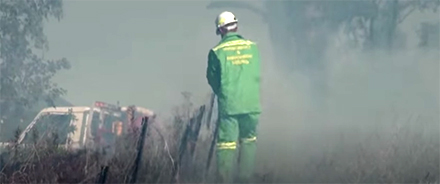The Auditor-General has cast doubts on the Victorian Government’s ‘Safer Together’ bushfire policy, citing insufficient information to judge its effectiveness, while the amount of prescribed burns is well below target. Source: Philip Hopkins for Timberbiz
The Auditor-Generals’ ‘Reducing Bushfire risk’ report, tabled in Parliament earlier this month, found that there was insufficient information available to understand the effectiveness and impacts of the government agencies’ risk-reduction activities.
Agencies examined were Department of Environment, Land, Water and Planning (DELWP), Parks Victoria, the Country Fire Authority (CFA), Emergency Management Victoria, Energy Safe Victoria and three local councils – East Gippsland, Murrindindi and Whittlesea.
The report’s key conclusions were:
- Over the past four years, DELWP has prescribed burnt only 86,744 hectares rather than the 200,000 to 275,000 ha required to achieve the 70% residual risk target, with the target only achieved by including areas burn by large bushfires. ‘Safer Together’ aims to reduce the state’s bushfire risk to or below 70% of what it would be without risk-reduction treatment.
- In 2019-20, DELWP delivered only 43% of the ‘priority’ burns and only 30 per cent of ‘normal ranked’ burns.
- Reducing risk across the state also requires a strong focus on treating private land to complement action on public land.
- Modelling limitations and lack of reporting on non-burn action (planning and building controls) and on private land constrain government and DELWP’s ability to make informed decisions to further reduce risk. DELWP says it will be able to measure the impact of non-burn treatments by late 2021.
- DELWP does too few fuel hazard assessments after planned burns and bushfires, reducing its ability to validate how quickly fuel re-accumulates to hazardous levels.
- DELWP advised government that it could reduce Victoria’s bushfire risk by 30% with the $50 million in annual funding allotted to it but did not point out it could achieve greater risk reduction with more investment.
- The program to make powerline safer has had successes, but the legislative requirement to bury bare-wire powerlines will take 30-50 year to complete, still leaving bushfire risk.
“We did not examine frontline bushfire response or emergency management,” the report said.
The report said the hectare-based fuel reduction target arising from the 2009 Black Saturday bushfires was replaced in 2015 by the Inspector-General for Emergency Management’s risk reduction target. This prioritises burns in areas that will reduce the most risk and led to the ‘Safer Together’ policy.
A Latrobe Valley consultant and forestry expert, John Cameron, said the fact that 70% residual risk level target was only reached by including large bushfires was “a nonsense”.
“Large bushfires are the outcome the policy was meant to avoid. Further it has been shown that wildfire is not as effective as low intensity prescribed burning in reducing risks from subsequent bushfires,” he said.
Mr Cameron, from Traralgon and a former general manager of Australian Paper Plantations, said fire behaviour experts believe 70% residual risk is way too high.
“Excessive fuel contributed substantially to last summer’s bushfire losses along with delayed initial attack and poor suppression under favourable weather in the two weeks after ignition,” he said.
Mr Cameron said Victoria’s 2019-20 mega bushfire could have been prevented if south-west Western Australia’s best practice fire mitigation policy had been in place. The 2009 Royal Commission recommended 5% fuel reduction each year, while experts called for 8% in line with WA practise. Victoria ignored the recommendation and introduced ‘Safer Together’.
“The resulting prescribed burning was 2%, well below the (Royal Commission) target. Last summer about 1.6 million ha was burnt, 396 houses destroyed, businesses irreparably damaged and five lives lost,” he said. “’Safer together’ was not safer, or more effective, not what local rural communities wanted.”
The Auditor-General said power lines had started many of Victoria’s major bushfires. The Powerline Bushfire Safety Program (PBSP), a $750 million, 10-year program to reduce this risk, includes two major parts – the $500 million Network Assets Project (NAP) and the $200 million Powerline Replacement Fund (PRF).
NAP involves safety switches with world first technology (rapid earth fault current limiters, or REFCLs) and other means that reduce the risk of fires. PRF covers, insulates, buries or removes high-voltage barre-wire powerlines in 11 of Victoria’s 33 highest bushfire risk areas.
PRF was completed in March, ahead of its January 2021 deadline, for $188 million. “NAP is still ongoing,” the report said, with NAP’s final costs cost about $747 million. When NAP is completed in April 2023, its REFCL technology is expected to reduce the risk of powerlines starting bushfires by 33.7%.
“The PRF has reduced the risk of powerlines starting bushfires by 98% to 99% on treated powerlines.,” the report said. When NAP is completed, all high-voltage power lines in the 33 highest risk areas would be protected, reducing the risk level by 58.6%.
“Due to limited funding, DELWP was only able to insulate or bury 41% of the high-voltage bare-wire powerlines in 11 of the 33 highest bushfire risk areas,” the report said.
“Legislation requires electricity distribution businesses to bury remaining bare-wire powerlines in all of these areas at the end of their life. Based on their current replacement rate, DELWP and Energy Safe Victoria estimate that will take approximately 30 to 50 years to complete, which they consider too slow to reduce the remaining risk.”
The report said NAP’s REFCL technology, was operating at 19 zone substations on 17 total fire ban days in 2019-20. The technology was activated 49 times by electrical faults. “Twenty-four of these would have likely started a bushfire,” said the report. “Despite these faults, no fires started on REFCL-protected networks. The REFCLs potentially prevented ignitions at a time when Victoria was enduring catastrophic bushfire activity.”







